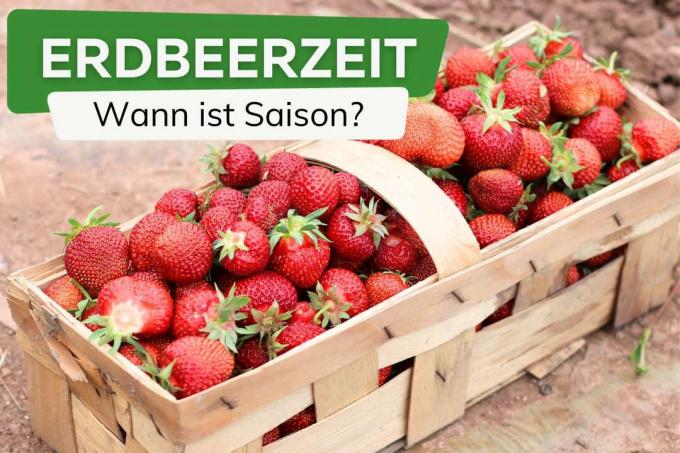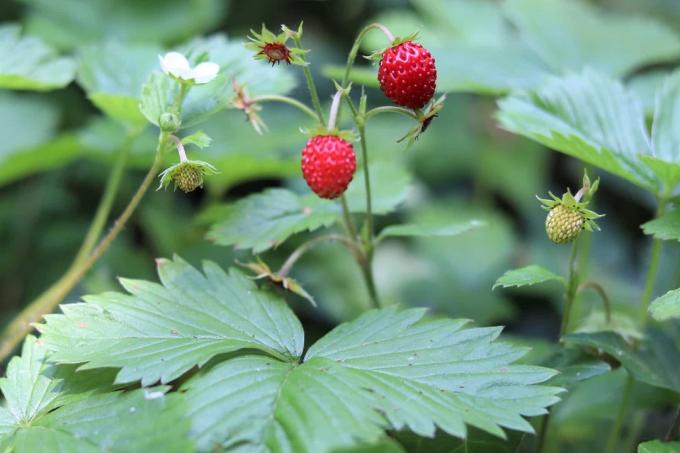
You might think that strawberry season lasts all year round, as you can buy fresh strawberries in supermarkets almost all year round. But it's the sweet fruits in particular that taste the best during the local season. Read here when the strawberry season begins and when it ends.
In a nutshell
- Peak season for strawberries between June and August
- The start of the season is often as early as mid-May
- made possible by early varieties and foil tunnels
- Extension of the season until October / November possible
- especially by choosing late varieties and monthly strawberries
Table of contents
- When is strawberry season?
- How can you harvest strawberries as early as possible?
- Can the strawberry season be extended?
- frequently asked Questions
When is strawberry season?
delicious strawberries are mainly harvested in Germany from June to August, which is why these months are also known as strawberry season. With mild temperatures and lots of sun the first fruits ripen however, already between the middle and the end of May on domestic fields. Depending on
variety and the prevailing weather, the harvest season can also be extended into September or even October.How can you harvest strawberries as early as possible?

If you want to harvest strawberries as early as possible, you need a warm, sunny spot in the garden and early-bearing strawberry varieties. These include these tried and tested, tasty specimens:
- 'Clery': very early variety with bright red, aromatic fruits
- 'Daroyal': French variety with large, aromatic fruits
- 'Elvira': old, very juicy and sweet variety, but not suitable for locations endangered by late frost
- 'Fraroma': is very robust against various strawberry diseases, e.g. B. wilt disease
- 'Honeoye': high-yielding, tasty variety, well suited for frost-prone locations
- 'Königin Luise': old, early variety with sweet, tender fruits, requires 'Ostara' as a pollinator
- 'Lambada': very early ripening, sweet fruits, robust plants
- 'Reuraths Very Earliest': very old variety with a particularly intense aroma
Depending on the planting and the weather, the varieties listed often ripen between the middle and end of May. If you start the strawberry season even earlier and from approx. want to harvest fresh strawberries at the end of April, plant them in early spring under foil tunnel. However, due to the lack of sun, these early-ripening fruits are usually not as aromatic as the specimens grown outdoors.

Source: Marianne Casamance, Frazier Marat des Bois, Edited from Plantopedia, CC BY-SA 4.0
A notice: The early varieties mentioned are once-bearing strawberries. If you want to harvest several times, you can rely on everbearing varieties such as 'Mara des Bois' or twice-bearing varieties such as 'Ostara' and can thus harvest uninterruptedly from June to August / September.
Can the strawberry season be extended?
In fact, the strawberry season can be extended with a few tricks. This includes, for example, that in addition to early and medium-early (e.g. B. 'Korona', 'Polka' or 'Sonata') late strawberry varieties are planted. These only ripen in midsummer, when the other varieties have already been harvested. This not only means that you can enjoy fresh strawberries from your own garden for longer - these late varieties are also particularly sweet and aromatic due to the intense sunlight. Recommended late strawberries are:
- 'Florence': robust with large, dark red fruits
- 'Pandora': particularly late maturing, with aromatic fruits
- 'Sweet Mary XXL': very large fruits
So-called monthly strawberries produce fruit continuously from June to October. Although these are often small, they are particularly aromatic. Recommended varieties include 'Amandine', 'Mara de Bois', 'Ostara', 'Rügen' or the particularly early-bearing 'Wädenswil'.

A notice: Monthly strawberries are cultivated forms of the wild, particularly aromatic ones wild strawberry. Incidentally, other wild strawberries such as the Chilean strawberry (Fragaria chiloensis) or the crackling strawberry (Fragaria viridis) can also be grown in the garden.
frequently asked Questions
Out of season, supermarket strawberries often come from the Mediterranean countries such as Spain, Italy, Greece, etc. From around May, however, German goods are often also available for purchase: In Germany, around 98,512 tonnes of strawberries were harvested from outdoor cultivation alone in 2022. A large proportion of this is grown in Lower Saxony and ultimately also offered in supermarkets.
No matter how tempting it may be: If possible, do not buy any imported strawberries outside of the local strawberry season! These fruits often come from Spain or other regions with water shortages, where they have to be artificially irrigated at great expense (which is at the expense of the ecosystems there, in southern Spain, strawberry and vegetable cultivation dries up about Europe's largest wetland, the Doñana) and also transports it to our supermarkets in a way that is harmful to the climate become. In addition, these strawberries are often heavily contaminated by pesticides.
In fact, strawberries are great for growing in pots, hanging baskets, boxes and other containers on the balcony, as long as it's sunny and warm. Varieties that bear fruit several times, such as the delicious monthly strawberries, are best suited for this purpose. When cultivating, make sure that you use soil that is as rich in nutrients as possible (e.g. B. Tomato or vegetable soil or a good compost soil) and to water and fertilize the plants regularly. The strawberries must not dry out, but should not experience waterlogging either.



